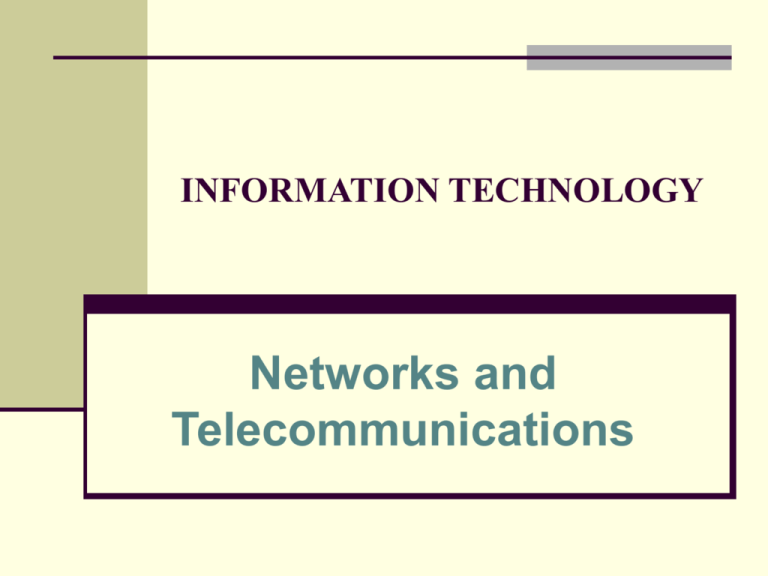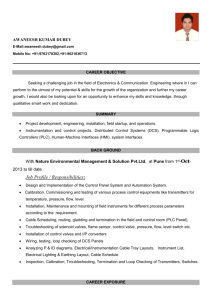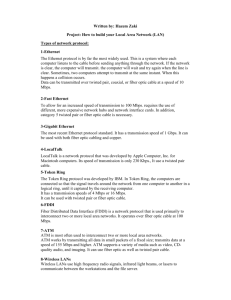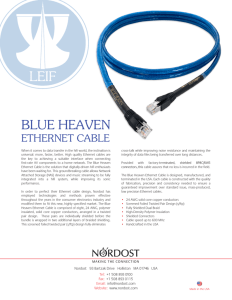Networks and Telecommunications
advertisement

INFORMATION TECHNOLOGY Networks and Telecommunications Learning Outcomes • • • • • • • • Summarize the individual components of a computer network Describe the three main network topologies Explain the difference between the three main forms of network access methods Summarize the difference between guided media and unguided media Explain how a network operating system works List the transmitting and receiving devices used in a computer network Describe the function of TCP/IP Summarize the use of a VPN 2 Introduction introduces the concept of computer networks Computer network (or network) - a group of two or more computer systems linked together using wires or radio waves over a geographical area Computer networks that do not use physical wires are called wireless takes a detailed look at the key concepts that are integrating computer networks and data communications 3 The Need for Networking A network provides two principle benefits: The ability to communicate The ability to share Groupware - software that supports team interactions and dynamics including calendaring, scheduling, and videoconferencing is the most popular form of network communication 4 The Benefits of Computer Networking Store virtually any kind of information at, and retrieve it from, a central location on the network Combines the power and capabilities of diverse equipment providing a collaborative medium to combine the skills of different people, regardless of physical location Enables people to share information and ideas easily They can work more efficiently and productively 5 Networking Basics Networks are assembled according to certain rules: Each cabling strand can only support a certain amount of network traffic, etc Topology - the actual physical organization of the computer devices including connections Bandwidth - indicates how much information can be carried in a given time period over a wired or wireless communications link 6 Networking Basics (continued) The network industry refers to nearly every type of network as an “area network” Local Area Network (LAN) - connects network devices over a relatively short distance Sometimes one building will contain a few small LANs, and occasionally a LAN will span a group of nearby buildings Wide Area Network (WAN) - is a geographically dispersed telecommunications network Metropolitan Area Network (MAN) - interconnects users in a geographic area or region larger than a local area network, but smaller than a wide area network Example: A university may have a MAN that joins together many of their local area networks situated around its campus 7 Networks – The Big Picture A network is made up of many physical elements: Computers, printers, and other devices The manner in which all these items are connected is referred to as the network topology Network topologies are further subdivided into two categories: Physical topologies Logical topologies 9 Physical Topologies the actual physical organization of the computers on the network and its connections Bus topology - all devices are connected to a central cable Star topology - all devices are connected to a hub Ring topology - all devices are connected to one another in a closed loop Tree topology - combines the characteristics of the bus and star topologies Wireless topology - all devices are connected by a receiver/transmitter to a special network interface card that transmits signals between a computer and a server; all within an acceptable transmission range 10 Physical Topologies Network Access Methods (Protocols) Protocol - the predefined way that someone (who wants to use a service) talks with or utilizes that service The most popular LAN protocols include: Token Ring Ethernet Fiber Distributed Data Interface (FDDI) 12 Token Ring Token ring network - a LAN in which all computers are connected in a ring or star topology and a token-passing schema is used in order to prevent the collision of data between two computers that want to send messages at the same time Second most widely used protocol on local area networks Data transfer rates of either 4 or 16 megabits per second 13 Ethernet Ethernet is the most widely installed LAN access method originally developed by Xerox When it first began to be widely deployed in the 1980s, Ethernet supported a maximum data rate of 10 megabits per second (Mbps) Fast Ethernet standards have extended traditional Ethernet technology to 100 Mbps peak Gigabit Ethernet technology extends performance up to 1000 Mbps 14 Ethernet and Token Ring Network Fiber Distributed Data Interface (FDDI) FDDI - a set of protocols for sending digital data over fiber optic cable FDDI networks are token-passing networks that supports data rates of up to 100 megabits per second FDDI networks are typically used as backbones for wide area networks 16 Fiber Distributed Data Interface Networking Hardware To be sent from one location to another, a signal must travel along a physical path The physical path that is used to carry a signal between a signal transmitter and a signal receiver is called the transmission medium Network transmission media - the various types of media used to carry the signal between computers Two types of transmission media: Guided and Unguided 18 Guided media Transmissions material manufactured so that signals will be confined to a narrow path and will behave predictably Three common types of guided media are: twistedpair wiring, coaxial cable, and fiber optic cable 19 Twisted-Pair Wiring a type of cable composed of four (or more) copper wires twisted around each other within a plastic sheath The wires are twisted to reduce outside electrical interference The RJ-45 connectors on twisted-pair cables resemble large telephone jacks 20 Coaxial Cable cable that can carry a wide range of frequencies with low signal loss Consists of a metallic shield with a single wire placed along the center of a shield and isolated from the shield by an insulator Two different types Thinnet coaxial cable - similar to the cable used by cable television companies Thicknet coaxial cable - similar to thinnet except that it is larger in diameter 21 Fiber Optic Cable Fiber optic (or "optical fiber") - the technology associated with the transmission of information as light impulses along a glass or plastic wire or fiber Optical fiber cable can transmit data over long distances with little loss in data integrity Optical fiber is not subject to interference 22 Cable Summary Unguided Media Unguided media - natural parts of the Earth’s environment that can be used as physical paths to carry electrical signals Examples include microwaves, infrared light waves, and radio waves 24 Transmitting and Receiving Devices Network adapters Modems Repeaters Wiring concentrators, hubs, and switches Bridges, routers, Microwave transmitters Infrared and laser transmitters Cellular transmitters Wireless LAN transmitters and gateways 25 Network Adapters Network adapter - the hardware installed in computers that enables them to communicate on a network The most common form is designed to be installed directly into a standard expansion slot inside a PC 26 Modems Modems - provide the means to transmit digital computer data typically over ordinary telephone lines The transmitting modem converts the encoded data signal to an audible signal and transmits it A modem connected at the other end of the line receives the audible signal and converts it back into a digital signal for the receiving computer Modems are commonly used for inexpensive communications between a network and geographically isolated computers 27 Repeaters used to increase the distance over which a network signal can be propagated A signal travels through a transmission medium, it encounters resistance and gradually becomes weak and distorted The repeater receives the network signal and retransmits it at the original transmission strength 28 Concentrators, Hubs, and Switches Concentrators, hubs, and switches - provide a common physical connection point for computing devices Most hubs and all wiring concentrators and switches have built-in signal repeating capability to perform signal repair and retransmission 29 Bridges, Routers, and Gateways used to interconnect network segments Bridges Routers Bridges and routers - generally used to connect networks that use similar protocols Gateways used to connect networks that use dissimilar protocols; examples includes TCP/IP and IPX 30 Microwave Transmitters & Receivers commonly used to transmit network signals over great distances 31 Infrared and Laser Transmitters Infrared and laser transmitters - similar to microwave systems: they use the atmosphere and outer space as transmission media They require a line-of-sight transmission path Useful for signaling across short distances where it is impractical to lay cable 32 Cellular Transmitters Cellular transmitters - radio transmissions and therefore have the advantage of being able to penetrate solid objects A cellular base station at the center of each cell contains: Low-power transmitters Receivers Antennas Common control computer equipment Cellular devices are configured to operate at low power to avoid interfering with other cellular devices in the area 33 Wireless LAN Transmitters function like hubs and switches in a wired environment, only they propagate signals through radio waves or infrared light instead of wires 34 The Network Operating System an operating system that includes special functions for connecting computers and devices into a local area network Two categories: Client-server Peer-to-peer 35 Client-Server Networks a versatile, message-based, and modular infrastructure that is intended to improve usability, flexibility, interoperability, and scalability as compared to centralized, mainframe computing 36 Thin Client-Server Networks Thin clients - similar to terminals connected to mainframes, the server performs the bulk of the processing, and the client presents the interface Thin clients are usually devoid of floppy drives, expansion slots, and hard disks; consequently, the “box” or central processing unit is much smaller than that of a conventional PC 37 Peer-to-Peer Networks Enable networked computers to function as both servers and workstations 38 Internet Technology The world’s largest computer network Two most influential technologies: Transmission Control Protocol/Internet Protocol (TCP/IP) suite World Wide Web (WWW) 39 TCP/IP TCP/IP - a group, or suite, of networking protocols used to connect computers on the Internet Two main protocols in the suite are: TCP provides transport functions, ensuring, among other things, that the amount of data received is the same as the amount transmitted The IP part of TCP/IP provides the addressing and routing mechanism 40 The TCP/IP suite of applications File Transfer Protocol (FTP) - allows files to be downloaded off or uploaded onto a network Simple Mail Transfer Protocol (SMTP) - TCP/IP’s own messaging system for e-mail Telnet protocol - provides terminal emulation Hypertext Transfer Protocol (HTTP) - allows Web browsers and servers to send and receive Web pages Simple Network Management Protocol (SNTP) allows the management of networked nodes to be managed from a single point 41 The TCP/IP Protocol Suite World Wide Web The World Wide Web is a client-server environment Information is managed through Web sites on computers called Web servers Accessing Web sites is done through the use of client software (i.e., a browser) and the Internet’s HTTP Computers and Web sites on the Internet are linked through documents called Web pages written in HTML 43 Intranet vs. Extranet Intranet – an internalized portion of the Internet, protected from outside access, that allows an organization to provide access to information and application software to only its employees Extranet - a private network that uses the Internet protocol and the public telecommunication system to securely share part of a business's information or operations with suppliers, vendors, partners, customers, or other businesses 44 Virtual Private Network (VPN) VPN - a private WAN that uses the Internet as a low- cost WAN backbone to transport data between two or more geographically separate sites Advantages that a VPN has over a dedicated-line WAN: The cost of implementation No need to lay cable or lease dedicated lines between the remote sites needing to connect Businesses can network remote offices into one large WAN and provide access to the Internet 45 Intranet, Extranet, and VPN Technologies







